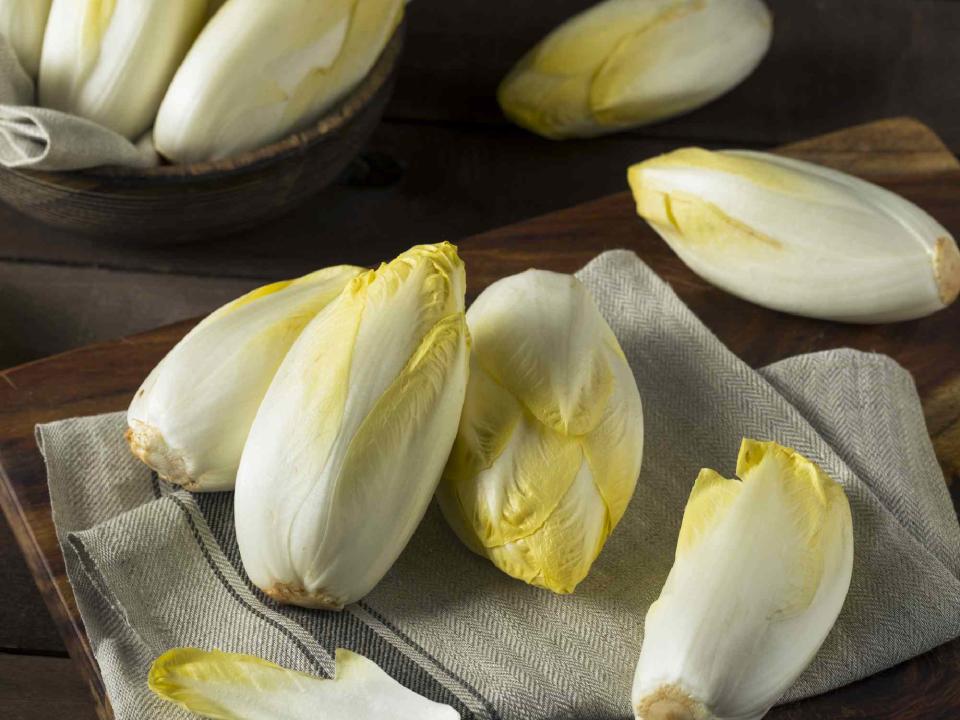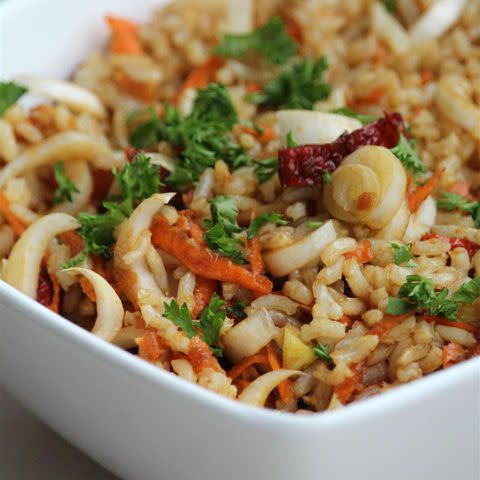What Is Endive?
It’s no surprise that chefs and home cooks alike are opting for endive's sleek sophistication and unique flavor.

Whether you’ve read it on a menu, heard about it on a popular cooking show, or even seen it in a grocery store, endive’s popularity and availability seem to be more and more prevalent. A versatile and fresh leafy green that presents beautifully in a multitude of dishes from appetizers to salads, it’s no wonder chefs and home cooks alike are opting for endive's sleek sophistication and unique flavor.
What Is Endive?
Endive is a bitter green descendant from wild chicory. It is a small, oval head of densely packed torpedo-shaped leaves, only about 6 inches in length. This head sports a decorative border that might be described as frilly, and while the leaves are pale, the border can be greenish-yellow or a deep violet shade.
The most well-known variety is Belgian endive, which technically isn’t true endive, but a type of radicchio (and just to be extra confusing, outside the US, Belgian endive is called witloof.)
Related: Belgian Endive Recipes to Make ASAP
Red endive, most commonly referred to as radicchio, adds both flavor and a punch of color to dishes like salads and coleslaw. It’s absolutely delicious when roasted or sauteed and added to pasta dishes.
Curley endive is more widely known as frisee. It has a more unruly appearance than the tame, tapered leaves of Belgian. Broad-leaved varieties with wavy edges are called escarole. This green is a cool weather crop – the fall and winter are the best times for shopping or eating. It’s also nutritious, packing high levels of potassium, calcium, and fiber.
What Does Endive Taste Like?
In its raw form, endive is crisp and bitter, often considered a bit of an acquired taste. If the vegetable had its own tagline, a good one would be “bitter crunch.” Cook the endive, however, and that bitterness all but melts away, revealing a soft, mellow, nutty, almost buttery flavor.
Related: What Are Chicory Greens and How Do You Cook With Them?
Ways to Use Endive
The hearty leaves of endive are most typically seen in salads, especially those inspired by French dishes or ingredients, or as a part of an appetizer. Their signature cupped, boat-like shape makes them a handy vessel to hold all manners of toppings or ingredients, or even a fresh alternative to chips or crackers for dip.
In its raw form, endive pairs exceedingly well with rich, fatty things, like poached eggs, bacon, or even a creamy soup. Citrus is another beautiful combination with its bitter, robust crunch. A simple drizzle of olive oil and balsamic perfectly appreciates this elegant vegetable.

Get the recipe: Brown Rice Belgian Endive Salad
Endive is sturdy and holds up nicely to various cooking techniques, the best being roasting, grilling, or braising. Do not be deceived by its delicate appearance - you can rest assured it won’t fall apart or be mushy.
Cook the leaves just to a tender crisp and serve them as a side dish; braise the head whole, brush the leaves with vinaigrette and pop them on the grill, or use them to wrap meat or fish during cooking.
Where to Buy Endive
Local farmer's markets are naturally the best place to purchase endive if your locale is friendly to its growing. You’ll find endive locally during cool-weather months, but you’ll find it year-round in grocery stores, having been shipped in from California and, of course, Belgium.
Related: Don't Be Bitter About Bitter Greens — Here Are the Best Ways To Cut the Bitterness
Endive will be sold whole and unbagged in the store. It has a very distinctive shape, color, and texture so won’t be difficult to find. Just keep an eye out for any leaves that are wilted or brown and opt to add others to your cart. Radicchio, or red endive, is also sold as a head, but commonly seen as a part of bagged salad mix as well.
How to Store Endive
Endive doesn’t usually require any washing to use it, as the leaves aren’t exposed to soil and they’re packed sanitarily. This makes it incredibly easy to work with. But if you wash it, do so right before using. Store your endive unwashed in the fridge — in the vegetable drawer to be exact. It will keep at least a week, though red endive tends to last even longer.

